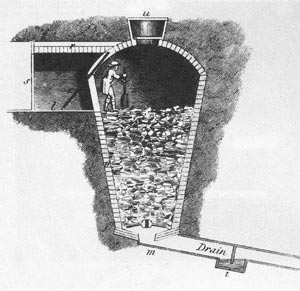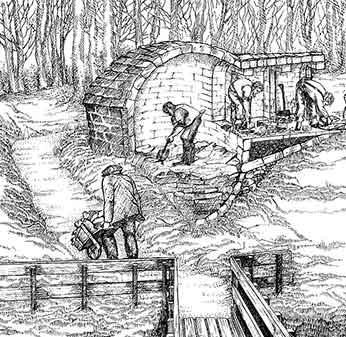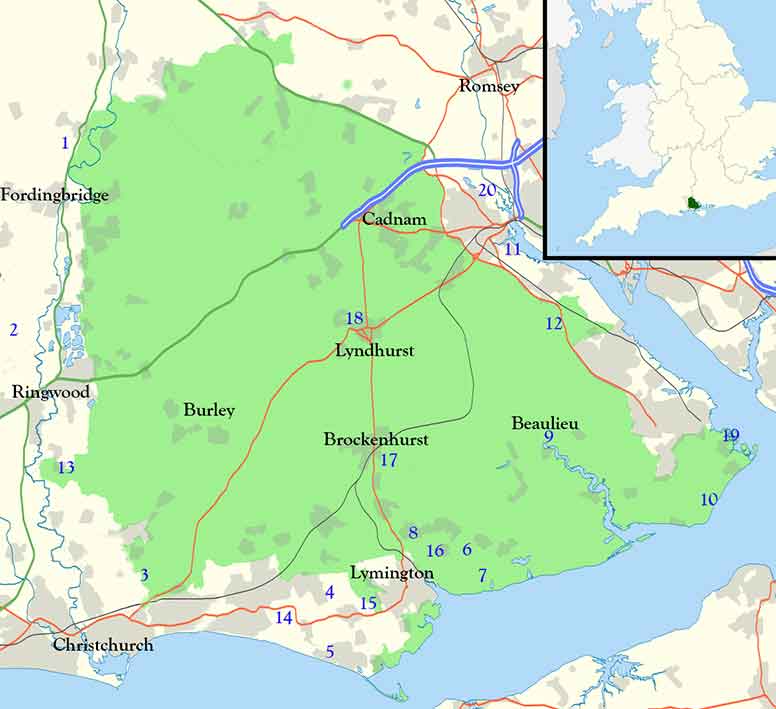New Forest Ice Houses

Universal Dictionary of Arts, Science and Literature
(s - doorway, l - air trap, r - entrance passage,
u - aperture through which ice may be put in)
Modern appliances such as the humble fridge are nowadays very much taken for granted, yet fridges only became generally available for household use in the 1920s, which is really not that long ago. Before then, fresh meat and other foodstuffs were often preserved by storing with salt in a process that worked reasonably well, if imperfectly. Few people had access to cold storage or to ice for drinks in summer and to produce ice cream. Apart, that is, from the wealthy who could afford to build and maintain an ingenious bit of kit to ease their lives: an ice house, or in some cases, multiple ice houses, innovative structures devised long before electricity became available for use.
Introduced as a concept into Britain during the early years of the 17th century, ice houses, to quote from the 1819 'Cyclopaedia or Universal Dictionary of Arts, Science and Literature', were '...a sort of building sunk in the ground for the purpose of preserving ice for use during the summer season, when the weather becomes hot'.
They usually comprised a brick or stone-built structure set above a domed, primarily underground pit (or well, as the pit was often known) lined with a thick layer of brick or stone, within which ice gathered from local lakes and ponds, some specially created for the purpose, or imported from colder climes, could be stored and retained for household use for periods of up to 18 months, or longer.

A worker packs down that already in the well. Two
other men are busy in the entrance passage.
(Image courtesy of the Eglinton, Ayrshire, archive)
Designs often included at the top of the dome, a ventilator which doubled as an access point through which small quantities of ice could be added to the store, and at the base of the pit, a means of drainage that allowed melt-water to run off.
Reeds, straw and similar materials were sometimes used for additional insulation, whilst access to the interior was provided through at least two close-fitting doors set a distance apart that, by never being simultaneously opened, created a reasonably effective airlock that reduced the inflow of warm air from outside.
Construction and maintenance of these buildings and ice stores was, of course, labour-intensive, but then, men's time was cheap and abundantly available.
Designs for attractive, ornamental ice house exteriors were available, but as Abraham Rees in the Cyclopaedia says: '....this is seldom done; the ice house being generally placed in a sequestered spot, on the side of a hill or sloping ground, the base of which is lower than the bottom of the well, the outside being well-banked up with earth to keep out all external air and heat, and neatly covered with turf or thatch'.
Nowadays, during our relatively mild Hampshire winters, it would, of course, be difficult to keep ice houses fully stocked with locally formed ice, but it was not always so, for the climate during the years between the sixteenth and nineteenth centuries (some experts say the years between 1300 and 1870) was considerably colder than that of today, to the extent that the period has become known as the Little Ice Age.
Mainly recalled by old place names, such as Icehouse Park at Breamore; intriguing entries on historic maps; and mysterious mounds with dark foreboding entrances, ice houses were quickly, understandably abandoned in favour of the fridge (and maybe, in part, as sufficient quantities of local ice became increasingly difficult to source) and rapidly fell into disrepair, out of sight within the grounds of the large houses that they previously served so well.
Nationally, it has been suggested that there are around 1,500 surviving ice house sites, a small number of which still have associated ponds present, whilst in and around the New Forest National Park area, at least 20 such sites are known. The 1982 Southampton University Industrial Archaeology Group publication 'Ice and Icehouses through the Ages' provided evocative descriptions of those that had been identified at that time.
Visible remains, often half-hidden under a mound of earth, were identified in the grounds of:
- Breamore House
- Somerley Park, near Ringwood
- Beech House, Bransgore
- Arnewood House, Hordle
- Rookwood, Milford-on-Sea
- Newtown Park, South Baddesley
- Pylewell House, Lymington
- Vicar's Hill Farm, Boldre
- Palace House, Beaulieu
- Cadland House, Stanswood
- Bury Farm, Marchwood
- Marchwood Park, Marchwood
Sites where remains could no longer be found were at:
- Bisterne House, Sopley
- Ashley Clinton, Hordle
- Efford House, Milford-on-Sea
- Walhampton House, Lymington
- Brockenhurst Park, Brockenhurst
- Northerwood House, Emery Down, near Lyndhurst
- Cadland House, Fawley
- Testwood House, Totton
(Paul Gamage has subsequently advised that the Greater Testwood Ice House was to the north-west of Greater Testwood House. It could still be accessed in the early 1970s but it gradually became overgrown).
Ice House sites in and around the New Forest National Park

Few, if any, of those with visible remains are in what could be described as good condition, although that might be about to change for the New Forest National Park Authority, as part of the £4.5 million 'Our Past, Our Future Landscape Partnership Scheme', has begun the development phase of a larger project set up to record details of known ice houses in the New Forest and identify previously unknown structures, before undertaking repairs.
As part of this early work, heritage technology firm Archaeovision was also commissioned to produce a high tech laser scan animation of an ice house on the Beaulieu Estate. The fascinating result can be viewed below.
More links
Search this site

Sadly, 58 animals were killed - 35 ponies, 13 cows, 8 donkeys and 2 sheep, whilst a further 32 were injured - 3 pigs, 9 donkeys, 11 cows and 9 ponies.
(Forty-three accidents occurred in daylight, 15 at twilight and 101 in the dark. Twenty-seven accidents were not reported by the driver involved).
Here's just one horrific example - Three donkeys killed in collision with van at notorious New Forest blackspot (Advertiser and Times)

